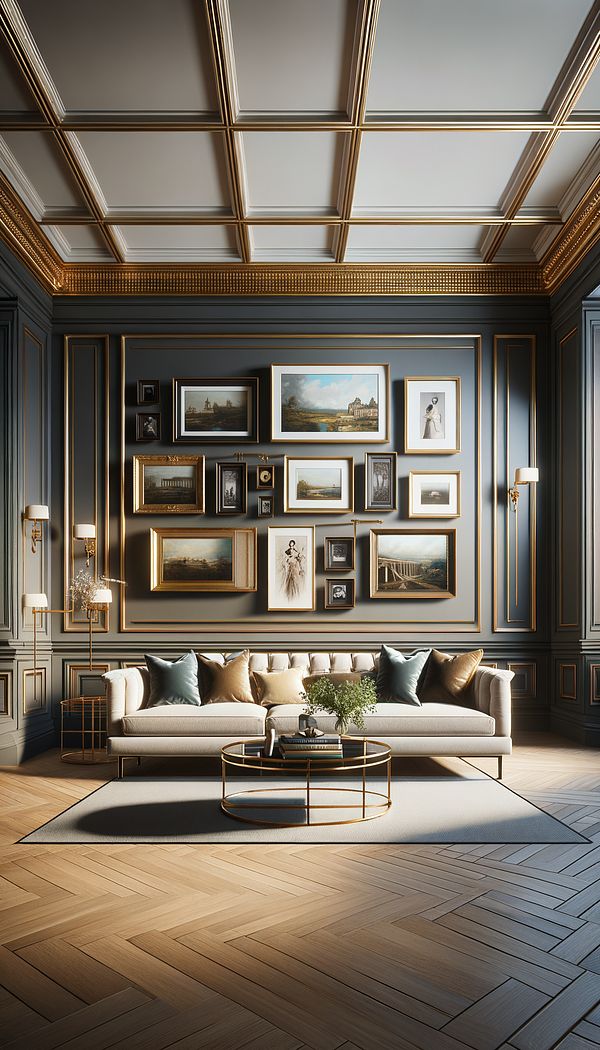What is a Gallery Rail?
A gallery rail is a type of railing or molding designed to display artwork or decorative objects.
Description
A gallery rail, often featured in the design schemes of galleries, museums, libraries, and homes, serves as a decorative and functional element that lines the perimeter of a wall or furniture piece. It typically consists of a horizontal bar or series of hooks situated just below the ceiling or along the upper portion of a wall. This rail allows for the hanging and display of artworks, photographs, and decorative items without the need for puncturing or damaging the wall surface itself.
Traditionally, gallery rails were made from wood or metal and could feature intricate designs, enhancing the aesthetic appeal of a space. Nowadays, they come in various materials, including stainless steel, bronze, and even plastic, offering a range of styles from the traditional to the modern. Such versatility makes the gallery rail a popular choice among interior designers and homeowners aiming to add a touch of elegance and sophistication to their interiors, alongside practical benefits for art display.
Installing a gallery rail provides a flexible solution for rotating displays, making it easier to change artworks or decorations according to seasons, themes, or personal preferences without the hassle of using different hanging systems or repairing walls. It's particularly advantageous in spaces where the visual representation is regularly updated or where wall integrity is a priority.
Usage
In historical homes, gallery rails are often found bordering the upper walls of dining rooms or libraries, showcasing family portraits or cherished collectibles. Modern applications see them in living rooms, hallways, and bedrooms, where they serve as a stylish method for displaying art collections, framed photographs, and even children's artwork. Furthermore, gallery rails on furniture pieces like bookcases or cabinets are not uncommon, providing an additional ornamental touch while offering functionality for displaying small decorative objects.
FAQs
-
Can gallery rails only be used for hanging artwork?
No, gallery rails are versatile and can also be used to display decorative items, such as small sculptures, plates, and even fabric art. They offer a convenient way to showcase various treasures without taking up floor or shelf space.
-
Are gallery rails easy to install?
Yes, gallery rails can be relatively easy to install, depending on the design and material. Most can be mounted directly onto walls with basic tools and hardware. However, for heavier loads or specific materials, professional installation may be recommended.
-
Can gallery rails be customized?
Absolutely, gallery rails can be customized in terms of length, material, color, and design to perfectly match the interior of any space. Customization allows for a more cohesive and personal touch to the decor.
Practical Application
When incorporating a gallery rail into your design, consider the height and placement carefully. It should be positioned high enough to elevate artwork, yet accessible for easy adjustments and changes. Additionally, match the style and material of the gallery rail to the room's overall decor for a seamless fit. Utilize the flexibility of a gallery rail to regularly update the displayed items, keeping the interior fresh and engaging. Finally, ensure the gallery rail's load capacity is suitable for the items you plan to display to avoid any accidents.
-
Architectural Elements199 articles
-
Furniture Types599 articles
-
Decorative Techniques322 articles
-
Decorating Principles & Elements330 articles
-
Wall Treatments & Finishes157 articles
-
BattingBatting is a layer of material used to provide padding and insulation.
-
MarbleMarble is a timeless, elegant natural stone often used in interior design.
-
Trundle BedA bed designed to save space, which stores an additional bed underneath.
-
MatelasséMatelassé is a weaving or stitching technique that gives fabric the appearance of padded quilting.
-
Color WheelThe color wheel is a visual representation of colors arranged in a circle, showcasing the relationships between primary, secondary, and tertiary colors.
